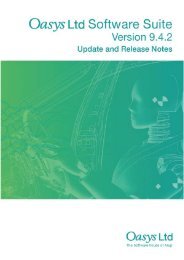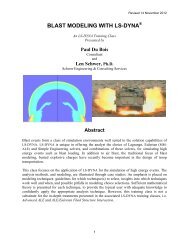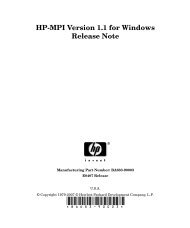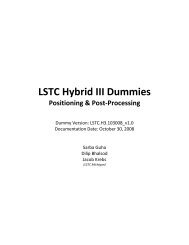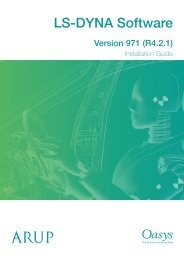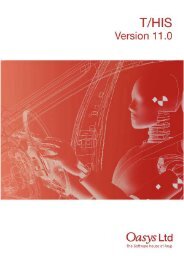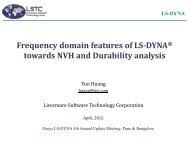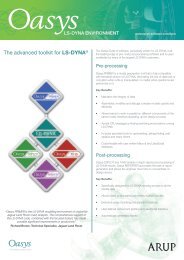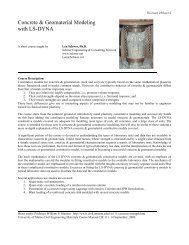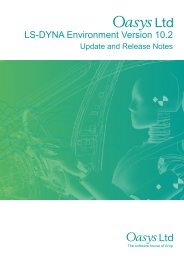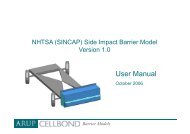Oasys LS-DYNA Environment 8.1 VOLUME 3 ... - Oasys Software
Oasys LS-DYNA Environment 8.1 VOLUME 3 ... - Oasys Software
Oasys LS-DYNA Environment 8.1 VOLUME 3 ... - Oasys Software
You also want an ePaper? Increase the reach of your titles
YUMPU automatically turns print PDFs into web optimized ePapers that Google loves.
<strong>Oasys</strong> <strong>LS</strong>-<strong>DYNA</strong> <strong>Environment</strong>: User Guide (Version <strong>8.1</strong>)<br />
The formula is:<br />
failure strain = ln (original area)<br />
area at failure<br />
Resultant plasticity (type 28) can be used with Shell or Belytschko-Schwer beam elements to<br />
bypass the normal solution method which calculates stresses at each integration point in the<br />
cross-section. This is computationally cheaper but can be inaccurate in some situations.<br />
Strain rate sensitivity can be included in many of the material types e.g. types 3, 18 and 24 allow<br />
input of Cowper Symonds rate effect parameters. Typical values for mild steel are c = 1300s -1<br />
and p = 5. There is generally less rate effect in high strength steels. If experimental data is<br />
available, use the curve LCSR in material type 24 to define how the rate effect varies with strain<br />
rate the viscoplastic option gives much smoother response but at cost of higher CPU usage.<br />
CONCRETE<br />
Concrete can be represented using material type 78 (MAT_SOIL_CONCRETE), which includes<br />
both volumetric crushing and strain softening in shear (to simulate cracking).<br />
RUBBER<br />
Material type 27 (MAT_MOONEY_RIVLIN_RUBBER) is generally reliable. Others available<br />
include types 31, 77, 7 and 6. Of these, 7 is not recommended. For low strain applications type<br />
6 is recommended.<br />
FOAM<br />
Material types 38 (MAT_BLATZ_KO_FOAM), 53 (CLOSED_CELL_FOAM), 57<br />
(MAT_LOW_DENSITY_FOAM), 62 (MAT_VISCOUS_FOAM), 63<br />
(MAT_CRUSHABLE_FOAM), 75 (MAT_BILKHU_DUBOIS_FOAM) and 83 (FU-CHANG-<br />
FOAM) are all written specifically for foams. It is also possible to model foams using material<br />
types 5 (MAT_SOIL_AND_FOAM) and 26 (MAT_HONEYCOMB). <strong>Oasys</strong> recommend the<br />
following:<br />
! For materials which show permanent crush (e.g. expanded polystyrene, ureaformaldehyde<br />
foam, etc.), use material type 63. A stress-strain load curve is defined, and<br />
unloading is elastic.<br />
! For materials which show hysteretic stress-strain behaviour but which recover to close<br />
to the original shape, use material type 57. With HU set to 0.01 and BETA set to 0.0, the<br />
amount of hysteresis depends on SHAPE. SHAPE = 10.0 gives high hysteresis (most of<br />
the energy is absorbed) while SHAPE = 0.1 gives negligible hysteresis.<br />
Page 6.2



